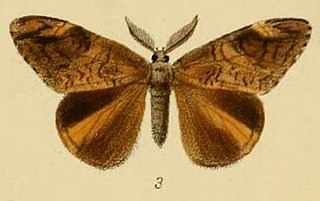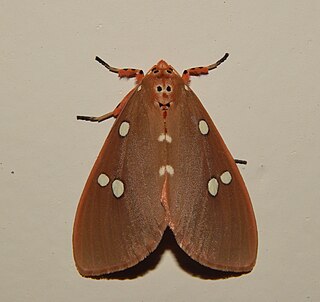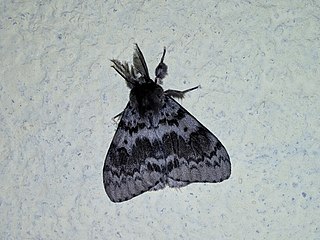
Aroa is a genus of moths in the subfamily Lymantriinae first described by Francis Walker in 1855. Species are distributed in South Africa, China, throughout India, Sri Lanka, Myanmar, and Java.

Laelia is a genus of tussock moths in the family Erebidae. The genus was described by Stephens in 1828. Species are well distributed throughout Europe, Japan, China, India, Sri Lanka, Myanmar and Java.
Rajendra biguttata is a moth in the family Erebidae. It was described by Francis Walker in 1855. It is found from southern India to north-eastern India and in Bangladesh and Sri Lanka.

Tinolius eburneigutta is a moth of the family Erebidae first described by Francis Walker in 1855. It is found in India, Sri Lanka, and Thailand.
Aroa plana is a moth of the family Erebidae first described by Francis Walker in 1855. It is found in India and Sri Lanka. The caterpillar is known to feed on Bambusa species.
Aroa subnotata is a moth of the family Erebidae first described by Francis Walker in 1855. It is found in Sri Lanka.
Lacida costalis is a moth of the family Erebidae first described by Francis Walker in 1855. It is found in Sri Lanka.
Euproctis bimaculata is a moth of the family Erebidae first described by Francis Walker in 1855. It is found in India, Sri Lanka and Thailand.
Orgyia viridescens is a moth of the family Erebidae first described by Francis Walker in 1855. It is found in Sri Lanka.
Laelia cardinalis is a moth of the family Erebidae first described by George Hampson in 1893. It is found in Sri Lanka.
Laelia exclamationis is a moth of the family Erebidae first described by Vincenz Kollar in 1848. It is found in Sri Lanka, India and Taiwan.
Laelia fasciata is a moth of the family Erebidae first described by Moore in 1883. It is found in Sri Lanka, India and Myanmar. One subspecies is recognized, Laelia fasciata rubripennisMoore, 1884.
Laelia suffusa is a moth of the family Erebidae first described by George Hampson in 1893. It is found in Bangladesh, Sri Lanka, Java, East Indies, Sundaland, the Philippines and Sulawesi.

Lymantria ampla is a moth of the family Erebidae first described by Francis Walker in 1855. It is found in India and Sri Lanka.
Lymantria grandis is a moth of the family Erebidae first described by Francis Walker in 1855. It is found in Sri Lanka.

Lymantria incerta is a moth of the family Erebidae first described by Francis Walker in 1855. It is found in India and Sri Lanka.
Lymantria marginata is a moth of the family Erebidae first described by Francis Walker in 1855. It is found in India, Bangladesh, Sri Lanka and Thailand.
Callopistria apicalis is a moth of the family Noctuidae first described by Francis Walker in 1855. It is found in the Indian subregion, Sri Lanka, Sundaland and the Philippines.

Narosa conspersa is a moth of the family Limacodidae first described by Francis Walker in 1855. It is found in Sri Lanka.






